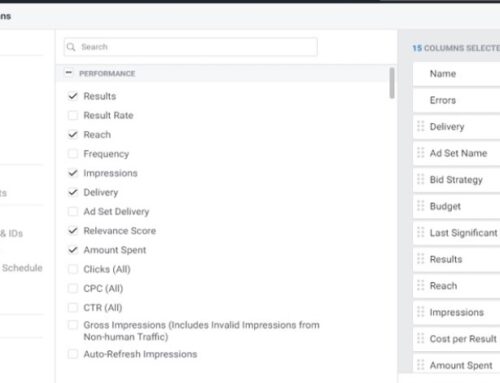Table of Contents
What is copywriting in Google Ads?
Want to learn how to write high-performing Google Ads? Based on Wikipedia definition of copywriting: “the act or occupation of writing text for the purpose of advertising or other forms of marketing. The product, called copy or sales copy, is written content that aims to increase brand awareness and ultimately persuade a person or group to take a particular action.”
When using Google Ads, you will also need to write ad copy. Every campaign involves some level of ad copywriting. The most obvious one is search ads. Advertisers write text ads that show up on the search results when someone types in something on Google.
Copywriting is a soft skill
You will realize that this article differs from the rest of the ultimate guides. This is the only article explaining soft skills. Hard skills are teachable skill sets that are easy to quantify—learning how to play the piano or learning a new language. Soft skills are like “people skills”. They are not quantifiable—things such as management, communication, leadership fall under soft skills.
Copywriting is a soft skill. Copywriting is salesmanship in words. Instead of having a sales team talk to every prospect, your ad copy now takes the role of a sales team.
A handy toolbox for copywriting
In this article, I will lay out 20 proven principles of Google Ads copywriting. Note that these are principles, not tips, and certainly not laws. Tips are generally small actionable stuff. They may only be reliable in some instances. But this toolbox is much bigger than that. I cannot claim “20 laws” because laws are generally unalterable. Hard and fast rules can never apply to a soft skill like copywriting.
So I have decided that “Principles” is the best word to settle on. These copy principles are generally accurate. But ultimately, you need to test it in the real world: in your own business. These principles are like tools for copywriting. Depending on real-life scenarios, you will need different tools each time. Think of this post as giving you a toolbox of the best possible tools for writing Google Ads copy.

Remember, you will not use all 20 tools in every single ad. That would be the wrong way to approach it. Your goal should be to use the best possible tools for each occasion. Your judgment is required. There are no “checkboxes” and lists “to tick off” in copywriting.
It will be up to you to use them properly.
20 proven principles of writing Google Ads copy
Before we start, we need to understand that Google Ads fall into the category of small advertisements. Most advertisements online are small. They are perfect as our attention span on the internet is hyper-fragmented. You are not writing a sales letter or a 2-page article about your product. Google Ads are small in size.
Google Ads resembles the classified section of a newspaper. Therefore, the first principle is understanding how to write within small spaces. Master the method of writing small ads. Such as saying a lot with little words. And no matter what you sell, it will pay off bountifully.
Let’s begin.
1. Mirror the searcher’s end goal
In the utopic world, your ad will always mirror the searcher’s end goal. Whatever they type in appears in your headlines almost like a mirror. For example, a search of “accounting software for small business” and only the first ad matches the searcher’s end goal. “Xero™ Accounting Software – Small Business Accounting”.
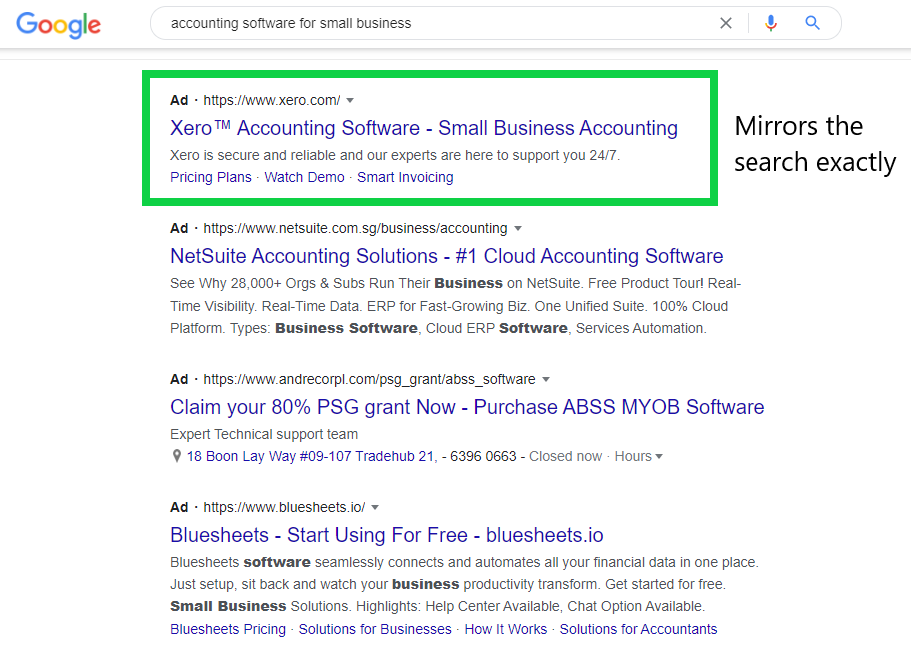
Well, that’s precisely what I’m looking for! Let’s look at the 2nd one; it talks about cloud accounting solutions. Which is not what I wanted. I may not even understand what it means, so the ad is ineffective. The 3rd one is just as bad. “Claim 80% PSG Grant” sounds good, but what if the deal is only for large businesses? That wouldn’t be right for me if I were a small business. On top of that, they use acronyms like “ABSS” and “MYOB”. This is expecting the reader to understand what it means. In short, industry jargon. Generally, you want to leave these away from your ads. Your customers don’t always speak your language.
The 4th one is hopeless as well. The headlines mentioned nothing (absolutely nothing!) about accounting software.
It is not hard to see why the first ad by Xero will succeed by a far fetch in getting the reader’s action. Users are not reading your ad for entertainment. They want to know how you can help them. Always remember to mirror the searcher’s goal.
2. Don’t waste precious ad space
Within Google Ads, there are only 90 characters in the headlines. On average, that is 1 typical sentence of around 15-20 words. You only get to write 1 sentence long in your headline. Every ad space counts. Make sure it justify it being in the headlines. In short, don’t waste precious ad space; it costs money.
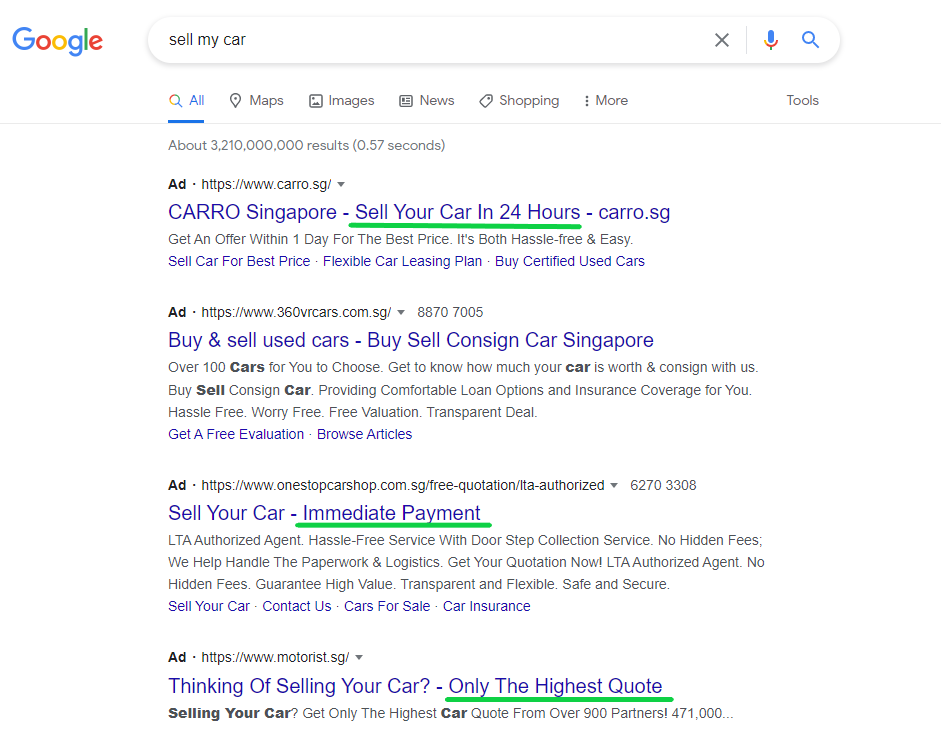
Look at the example above. The 3 headlines are essentially saying the same thing “Winter Bags”. Just how good are they? Are they 100% waterproof? What type of material is it made of? Are there free shipping and returns? What are its features and benefits? Make headlines unique and help the user understand what you are selling. Don’t waste precious ad space.
3. Get specific and verifiable.
“Quality Tax Preparation Services” Vs “$32,102 Saved in December” if you are someone looking to get help with your accounting, which ad would you prefer?
With the first one, anybody can claim it. Who will claim themselves to be low quality or “Unquality tax preparation”? Generic claims are terrible because the inverse is impossible to claim. Avoid them when you can. Specific and verifiable claims stand by their own, commands attention, and are much more believable.
Remember, get specific and make sure your claim can be verified.
4. Tell them what they want to hear, but be honest.
All these ads should focus on telling prospects what they want to hear, not what you want to hear.

Take a look at these 4 ads when I searched “sell my car”. Three of these ads did well, as they told me what I likely want to hear as a customer. “Sell my car in 24 hours” that’s promising an instant sale. The third ad mentioned “Immediate Payment” if I sold my car on your site. So I can get the money immediately into my bank account? Awesome. The 4th ad promised the highest quote; that’s good too.
Right here, we have some very strong contenders. You, as a potential customer, will probably want all these benefits. These headlines are good. They not only addressed what I wanted but also told me what I wanted to hear.
But remember that it has to be authentic and factual. For example, in the first ad, any person knows not all cars on that site get sold within 24 hours. But that still sounds good enough to sell him. As long as they have actual cars that sold in 24 hours, they can make that claim.
Remember, tell them what they want to hear, but be honest.
5. Make your ads hyper-local
Tell customers your business is nearby. People that want help usually want it quick. Nobody wants to get stuck with a problem and have to wait for weeks or months for a solution! Having your ad hyperlocal makes it seem like help is just around the corner. You are communicating “convenience”. If all things are equal, a hyper-local ad will almost always outperform a national-level ad.
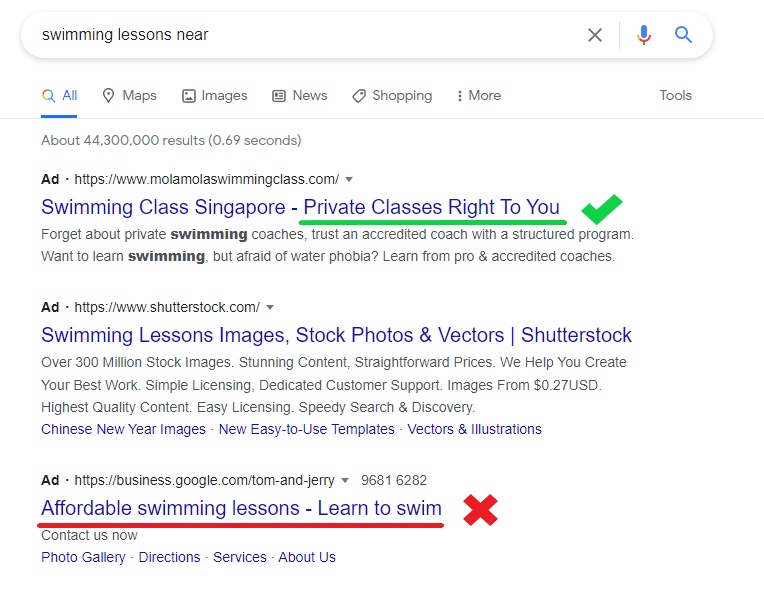
Look at the ads above for swimming lessons. The first ad let me know that the swimming lessons will be done near me. The third ad said nothing of that.
Remember to position your ads as hyper-local.
6. Use scarcity, provided it is real.
This technique can truly boost your ads provided it is real. People are usually afraid of missing out on a good deal or when something is limited. Let’s study an example.
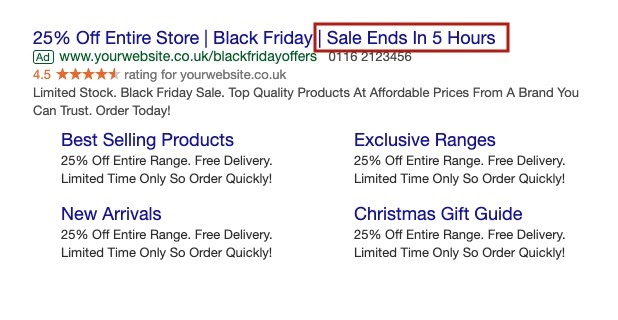
Here we have an ad promoting a Black Friday sale, giving 25% off the entire store. But note that this sale is not on for a long time, as it “ends in 5 hours”. Typically ads like this gain a higher click-through rate than a promotion that is not time-sensitive. An easy way to incorporate this in your Google Ads is to use the {{Countdown}} function.
However, make sure the scarcity is authentic. You don’t want to be a business that is known for exaggeration. Companies that run ads that claim the same “Clearance Sale” for the last 6 months are not going to get any attention. Customers learn to tune out of these ads. Advertising is an honest business. Don’t rely on artificial scarcity, the customer is not stupid.
Use scarcity, provided it is real.
7. Include a CTA
While researching this article, I have read dozens of copywriting articles online. This point was raised up in almost every article. And that is to include a Call-To-Action in your ads. It seems so simple that we often forget.
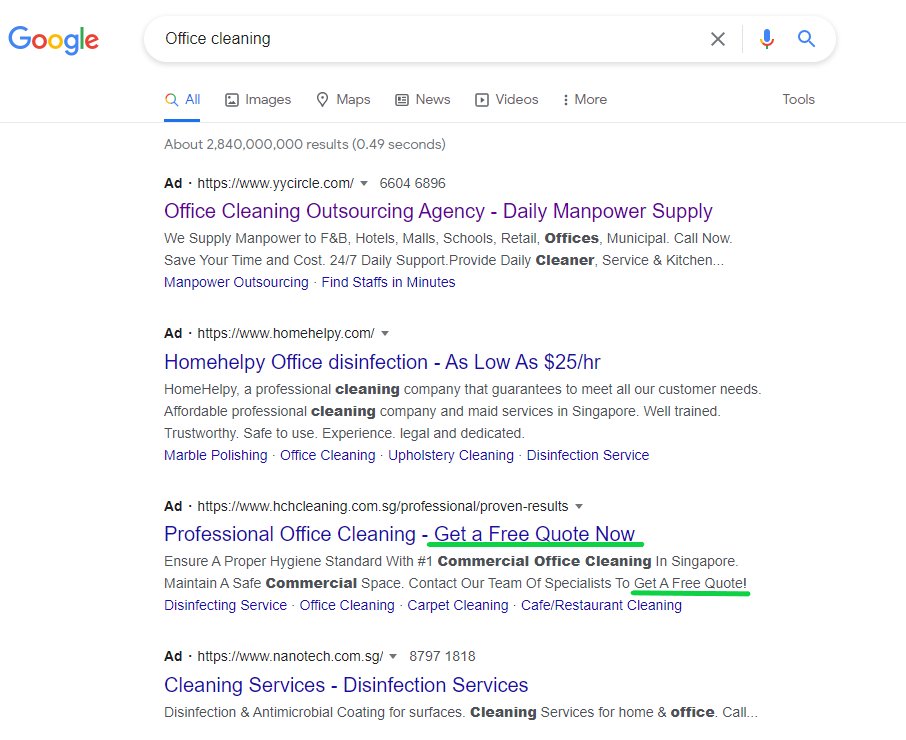
Out of the 4 ads, only 1 used a call to action in the headline and description. It is not necessary to repeat the CTA in both the headline and description. But at least have it somewhere in the ad.
Call-to-Actions are important because it serves as a reminder of what users should do. The user spends a few moments reading your ad, now a CTA kind of summarizes it and re-focuses them to “take this action” or get started in that direction.
Include a CTA in your ads.
8. Mirror keywords
When your ad copy closely mirrors the keywords in the search terms, it tells the user that your ad is highly relevant. It must be what they are looking for. The easiest way to do this is by using Dynamic Keyword Insertion (DKI) in your ads. This can be done with the function {{Keyword}}. If you are a searcher, which ad would you click on? The ad that mirrors your search term or one that has totally different?
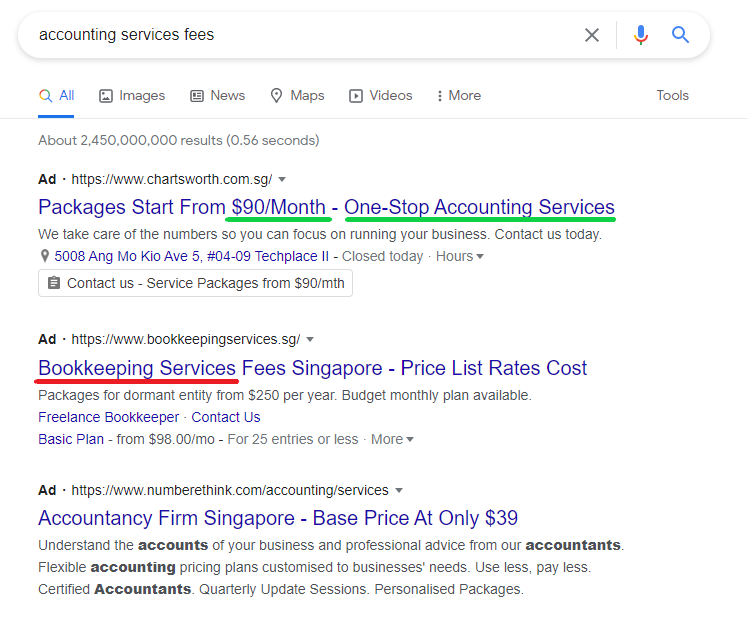
Let’s study the above example. I searched for “accounting services fees” and the first ad described exactly what I wanted. It had the keyword “accounting services” and told me straight up the starting fees.
The second ad is not a good example since it used “bookkeeping” instead of “accounting”. Ads that mirror the searcher’s keywords usually enjoy a higher CTR.
Remember to mirror keywords, as this tells the searcher you are on the same wavelength as them.
9. Test the headlines first
This principle is universal and applies to every type of ad. Most readers only read the headline before clicking the ad. The headline holds by far the most weightage in the entire ad.
Through a/b testing, you can find out precisely which sort of headline most appeals to your audience. Simply changing headlines can often multiply results.
Remember that when testing ads, test the headlines first.
10. Simplicity over complexity
Always avoid trying to sound clever or convoluted in your ads. Ads are not written to impress your friends or win literature awards. Once you understand that every ad’s purpose is to sell, and most people speak and understand in simple language, you will write in a simple style. Generally, avoid using words that the masses don’t understand.

The ad above is absolutely fine if the target audience knows what they are looking for. These are for people who are usually at the very late stages of research and know a good deal about the industry. If they are searching for “gallbladder surgery”, having this headline will prove difficult for most to understand.
In short, don’t use industry jargon unless you are certain your target audience knows what you are talking about. Simplicity over complexity.
11. Jump in with both feet
We often hear the terms put your best foot forward. When dealing with Google Ads, you can’t afford not to show your best. You either get the click or you don’t. The customer may never make a U-turn back to your site. Studying your business strengths allows you to put your best proposition forward. If every competitor only provides a 30-day warranty and you provide it for 45 days, you should blast this difference in your headlines. If there is a price difference between you and your market, you should let users know.
Study into what your business is providing in value. Compare the value your market is offering. And, if your business has the edge (offering the higher value), communicate it in your ads.
Jump in with both feet.
12. Gain trust through credibility claims
Gaining trust is a thorny issue for many businesses. Most users probably don’t know you well enough (if they do, they will likely be searching your brand name instead.) So what is the fastest way to gain trust in customers? Provide testimonials, reviews, awards you won. Tell of the influencers you partnered with is another good way of winning trust. The psychology of this is that you are telling users, “someone else has already vetted me”. Usually, the more credible the source, the more user trust you gain.
If you have amassed 526 reviews online, try putting “Reviewed by 526+ Users Online”.
Gain trust through credibility claims, and the more likely they will become your customers.
13. Saturate yourself with the knowledge of the product
This is not a copywriting technique but will surely improve your copy skills. The only way you can write great ads is if you have all the ammo available for launching a great ad campaign. Try to find and learn everything about the product and the business before writing anything. The more you know, the better you can write, and the fewer blunders you will make.
Study all the markets ads and products. Study your own products. Learn and read about the language of the industry, like how customers look for products and what words they use.
Saturate yourself with the knowledge of the product.
14. Don’t use negativity
Always present the positive, the good, and the wholesome. That is what all advertising should aim at. Customers are seeking happiness, beauty, satisfaction in every way. So don’t advertise the bad side of things. I will warn against using it to speak condescendingly about your competitors. It will leave a distaste to the readers.

The example ad (not actual) is an example of how not to write your ads.
Saying how bad your competitor’s products are is like trying to light a candle in the wind. Nobody believes you, as your standpoint is too biased to make an accurate judgment.
Don’t use negativity.
15. Don’t write useless things
This is a weird point – who wants to write useless things? Who admits that they write useless stuff? Nobody! But the market talks about sales and profits and whether you can convert a user into a customer.
Examples of useless things are talking about unrelated stuff than what you are selling, giving points that customers do not care about, and self-praising. Things that these don’t register in their heads. You wasted the ad space, and you paid for it. The headlines carry the most weight than any part of the ad.
So don’t write useless things.
16. Use powerful selling words
Writing small ads means you need to condense everything into a few words. Google Ads only gives you 90 characters to write down your headline. That is the average length of a sentence. This is where having a vocabulary of words pays well, bookmarking sites like https://www.thesaurus.com/ or https://www.dictionary.com/ will help you be efficient when writing ads. Writing ads on Google requires cutting down what you want to say into concise, productive chunks.
This is a long list of powerful selling words as listed out by Scribpress. Just incorporating a few of these words will significantly increase your creativity next time you write any ad copy.
Learn to use powerful selling words.
17. Avoid generic claims
This is the opposite of the earlier point of using specific and verifiable claims. Using generic language is appealing not all. Things like “We are the best”, “Check Our Amazing Products”. Just how are you the best? Who has verified that your products are amazing? It is easy to make generic claims as it does not require proof. Customers know this. That’s why they instinctively tune out to generic claims.
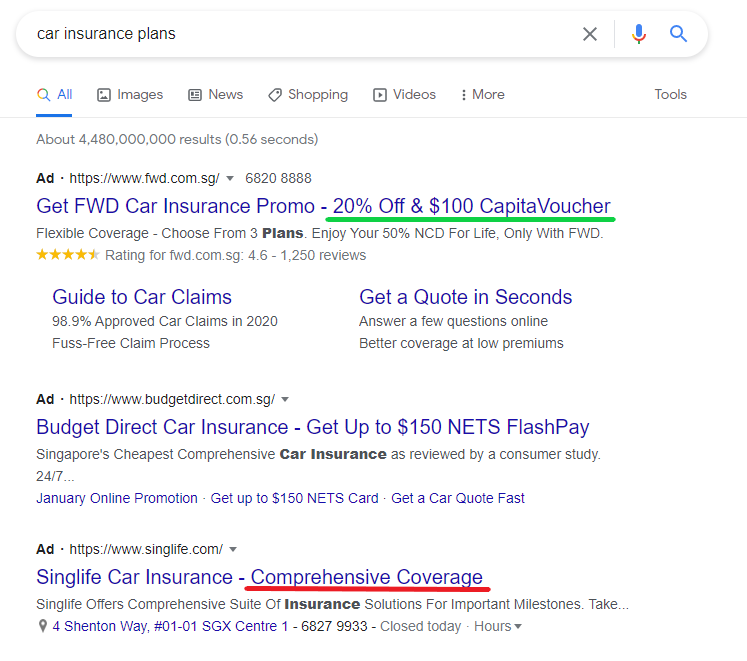
A search for car insurance plans shows these results. The first ad from FWD is what we want – clear specific numbers. While you look at the ad from singlife, “comprehensive coverage” is more generic. Therefore, it will probably not outperform FWD’s ad.
Remember to avoid generic claims.
18. Don’t worry about looking good
The first principle of advertising is sales. Focus your copy on selling by positioning it to be truly valuable to the reader. All humans are inherently selfish. It’s not a bad thing. People read your ads to see how you can help them. This point is exceedingly important. Too many advertisers tout their own horns by claiming how great they are as if writing for their families to read or thinking their competitors are watching.
Worry about communicating value to your customers, don’t worry about looking good.
19. Make use of descriptions strategically
Descriptions are longer than headlines, and it appears right below them. The description is twice the length of the headline. The best descriptions complement what is said in the headlines, or highlight additional information that is not said in the headlines. The problem is this: only 2 or 3 out of 10 readers will get to your description, but it’s OK. Use it as a safety net to further bolster your offer.

The same ad by FWD shows the power of writing great descriptions. In the description, it tells the user of their flexible coverage that comes in 3 different plans. A benefit of getting a daily transport allowance of up to $80 daily while their car is being repaired. As someone looking for car insurance, these will be helpful for them to consider.
Make use of descriptions strategically.
20. Master competitor searches
Competitor search terms. What do you do? Let’s start by explaining what are competitor searches first. These are users that search for your competitor’s name or brand that you closely compete with. These customers can be your customers, too. The act of bidding on your competitor keywords is what we call “PPC Conquesting”, an actual industry term. Let’s examine below.
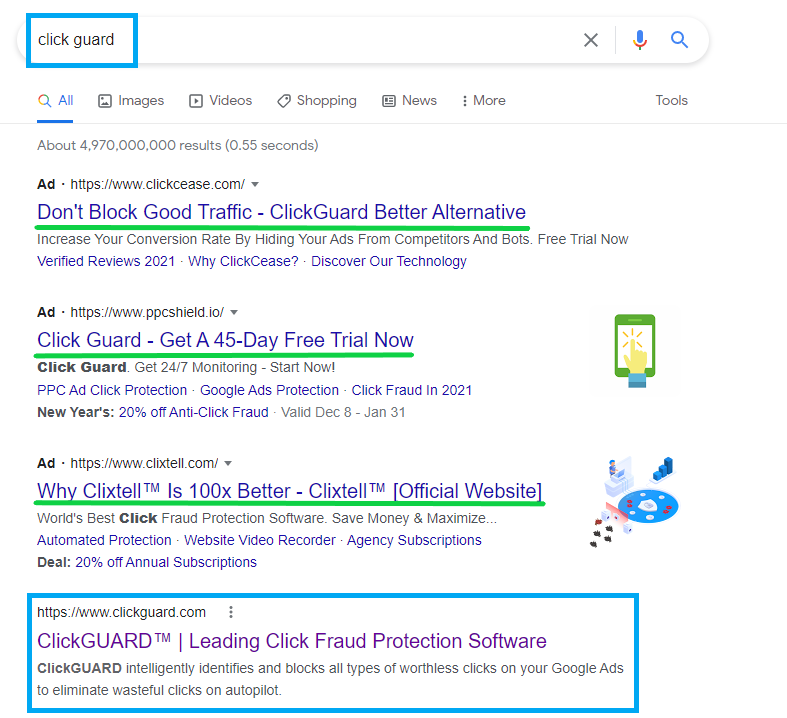
This is no doubt a brutal example, and I hope this doesn’t happen to any business. A search for “clickguard” shows 3 competitor ads fighting to win over the searcher. Companies like Clickcease, Clixtell, and PPC shield present themselves as alternative versions.
Say you are bidding for a few competitor names; how do we write ads for competitor searches?
The best advice is to put your best proposition forward. List out your strongest points, tell them why you are outstanding. You can also put your communicate your difference. In this way, you give the reader more choice. And remember the earlier principle, “Don’t use negativity”. You should practice it here. The last thing you want to do is throw shade at a competitor when the searcher is looking for them.
It pays to be always positive in your ads, even when running competitor keyword ads. Look to present yourself as the better option. If you are just the same as the competitor, your chances are slim.
Master competitor searches.
Copywriting produces no miracles
Remember, there is no correct way to write ads. Copywriting is a soft skill that you can improve on with practice. Copywriting cannot save a bad product as much as it can stop a brilliant product from succeeding. Marketing is always subordinate to the product, this includes your ad copy. You can write a compelling ad copy on a bad product, and it will still flop. The idea or “greatness” must be inherent in the product itself. Good copywriters can extract the “idea” from the product and present it to users.
There are general principles and guidelines within copywriting. But, never any hard rules. This is why ad testing and getting feedback in the real world are so important. The reader tells us what works and what does not. But having a handy toolbox of copy principles is an excellent start.
Be careful of dishonesty
Don’t put anything in your ads that are not true. Advertising is the business of helping people find good products. Anytime we use it for deceptive or manipulative methods, it will be detrimental to the business. The customer is savvy. He knows what value is and what is not. Manipulative and dishonest copy may win you the first sale from an unsuspecting person, but you can be sure that that is the only sale you will get from him. The words of dishonesty spread like wildfire. The business pays a double penalty for every “gain” received.
Honesty is not only the best policy but also the most profitable one.
Summary
There you have it! You should have a clear understanding of how to write copy in Google Ads by now.
We began the article by talking about how copywriting is a soft skill that improves with practice. Don’t look for hard and fast rules that work every time. It doesn’t exist. The best way we can improve at writing copy is through tireless, consistent practice. That will in time develop sound judgment when you write ads. We have gone through 20 proven principles of producing a good copy. Having a toolbox of copy principles will help guide you along your path to writing great Google Ads.
The path of writing effective ad copy is not a straight one. Its path is often off-road and usually through the thickets and dense trees. You have to test and iterate many times before landing on a great copy. The pot of gold at the end is waiting for those who will put in the effort.


